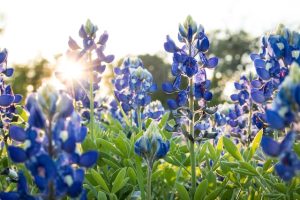Bluebonnets are the iconic wildflowers of Texas, known for their vibrant blue color and unique shape.
However, many people wonder if these beautiful flowers can grow in other states, such as Arkansas.
While bluebonnets are native to Texas, they can grow in other areas with similar growing conditions.
While bluebonnets are native to Texas, they can also grow in other areas with similar growing conditions.
In Arkansas, bluebonnets can be grown as annuals and require well-drained soil with full sun exposure.
It is important to note that bluebonnets may not grow as large or vibrant in Arkansas as they do in Texas due to differences in soil and climate.
Key Takeaways
- Bluebonnets can grow in areas outside of Texas with similar growing conditions.
- Bluebonnets require well-drained soil and full sun exposure.
- Bluebonnets can be grown as annuals in Arkansas, but may not grow as large or vibrant as they do in Texas.
Understanding Bluebonnets
Bluebonnets are a type of flower that belong to the Lupinus genus. The Texas bluebonnet (Lupinus texensis) is the most well-known species of bluebonnet and is the official state flower of Texas.
Bluebonnets are a type of legume and are known for their vibrant blue-purple color, which is why they are so popular in landscaping.
Bluebonnets are native to Texas and thrive in the state’s climate. They are typically found in the wild in fields and along roadsides. However, bluebonnets can be grown in other parts of the country as well, including Arkansas.
When it comes to growing bluebonnets, it’s important to understand their specific needs. Bluebonnets prefer well-draining soil that is slightly acidic.
They also require full sun for at least six hours a day. In terms of temperature, bluebonnets can tolerate a range of temperatures, but they prefer cooler temperatures between 60°F and 70°F (15°C and 21°C).
Bluebonnets are typically planted in the fall, although they can also be planted in the spring.
When planting bluebonnets, it’s important to scarify the seeds, which means scratching the seed coat to allow water to penetrate and stimulate germination.
This can be done by rubbing the seeds with sandpaper or soaking them in hot water.
In summary, bluebonnets are a beautiful and popular type of flower that can be grown in Arkansas and other parts of the country.
By understanding their specific needs, including well-draining soil, full sun, and cooler temperatures, gardeners can successfully grow bluebonnets and enjoy their vibrant blue-purple color.
Bluebonnet Growth Requirements
Bluebonnets are a type of lupine that require specific conditions to grow properly. Here are the key factors that determine whether bluebonnets can grow in Arkansas.
Soil and Drainage
Bluebonnets prefer well-drained soil that is slightly acidic. They can tolerate a variety of soil types, including sandy and clay soils, but the soil must have good drainage.
If the soil is too compacted or has poor drainage, the bluebonnet roots will not be able to grow properly, leading to stunted growth or even death of the plant.
Watering Needs
Bluebonnets require regular watering, especially during the germination phase. The soil should be kept moist but not waterlogged.

Once the plants are established, they can tolerate drought conditions but will still require occasional watering.
Sunlight Requirements
Full sun is essential for bluebonnets to grow properly. Bluebonnets require at least six hours of direct sunlight per day to thrive.
They can tolerate some shade, but too much shade will result in weak, spindly plants that are more susceptible to disease and pests.
In summary, bluebonnets can grow in Arkansas if they are provided with well-drained soil, regular watering, and full sun. With the right conditions, bluebonnets can add a beautiful splash of color to any garden.
Bluebonnet Planting Process
Bluebonnets are beautiful wildflowers that are native to Texas and can also grow in other states like Arkansas. If you’re interested in planting bluebonnets in your garden, here are the basic steps you need to follow.
Seed Selection
The first step in planting bluebonnets is selecting the right seeds. Bluebonnet seeds can be purchased from nurseries or online.
It’s important to choose seeds that are fresh and viable. Check the expiration date on the package to ensure that the seeds are not too old to germinate.
Germination
Once you have selected your seeds, you can start the germination process. Bluebonnet seeds usually take 10 to 12 days to germinate.
You can germinate the seeds by sowing them directly into the ground or by starting them indoors in a seed tray.
If you choose to start the seeds indoors, sow them 1/4 inches deep in a seed tray filled with potting soil. For faster germination, soak the seeds in water for 24 hours before sowing. Keep the soil moist and warm, and the seeds should sprout within 10 to 12 days.
Transplanting
Once the seedlings have sprouted and are about 2 to 3 inches tall, they are ready for transplanting. If you started the seeds indoors, you will need to harden off the seedlings by gradually exposing them to outdoor conditions.
When transplanting the seedlings, choose a sunny location with well-draining soil. Bluebonnets prefer slightly alkaline soil with a pH between 7.0 and 8.0. Dig a hole that is slightly larger than the root ball of the seedling, and gently place the seedling in the hole. Fill the hole with soil, and water the seedling thoroughly.
It’s important to note that bluebonnet seeds have a hard seed coat that can make it difficult for the seeds to germinate.
Scarification, which is the process of breaking or weakening the seed coat, can help improve germination rates. Scarification can be done by soaking the seeds in hot water for a few minutes or by rubbing the seeds with sandpaper.
By following these simple steps, you can successfully grow bluebonnets in your garden. With their vibrant blue flowers and unique shape, bluebonnets are sure to add a touch of beauty to any landscape.
Bluebonnet Care and Maintenance
Bluebonnets are hardy plants that require minimal maintenance. However, proper care can help ensure that they grow healthy and produce beautiful blooms. Here are a few tips on how to care for and maintain bluebonnets:
Fertilization
Bluebonnets do not require much fertilizer. In fact, too much fertilizer can cause the plants to produce more foliage than flowers. However, a light application of fertilizer can help promote healthy growth and blooming. It is recommended to apply a balanced fertilizer with an NPK ratio of 10-10-10 or 15-15-15 in early spring, just as the plants begin to grow. Be sure to follow the manufacturer’s instructions for application rates.
Pest Control
Bluebonnets are generally not susceptible to pests, but they can be affected by certain insects and diseases. Aphids, mites, and caterpillars are common pests that can damage bluebonnets. To control these pests, it is recommended to use an insecticidal soap or neem oil. Be sure to follow the manufacturer’s instructions for application rates and safety precautions.
Watering
Bluebonnets are drought-tolerant plants, but they still require regular watering. During the growing season, water the plants deeply once a week. It is important to avoid overwatering, as this can cause root rot. Additionally, bluebonnets do not require watering during the winter months when they are dormant.
In conclusion, bluebonnets are easy to care for and maintain. By following these simple tips, gardeners can enjoy healthy plants with beautiful blooms year after year.
Bluebonnets in Arkansas
Arkansas Climate
Arkansas has a humid subtropical climate with hot summers and mild winters. The state is divided into six different climate zones, each with its own unique characteristics. The northern part of the state is cooler than the southern part, and the Ozark Mountains receive more precipitation than the rest of the state.

Bluebonnets are native to Texas and are well adapted to the hot and dry climate of that region. While Arkansas has a similar climate, it is not clear if bluebonnets can grow successfully in the state. The Arkansas Game and Fish Commission recommends planting native wildflowers that are adapted to the state’s climate.
Native Wildflowers in Arkansas
Arkansas is home to over 600 native wildflowers, including the eastern bluestar and nodding onion. These wildflowers are adapted to the state’s climate and soil conditions and are an important part of the state’s ecosystem.
Planting native wildflowers in Arkansas is an excellent way to support local wildlife and pollinators. Native wildflowers provide food and habitat for bees, butterflies, and other pollinators, which are essential for the health of the ecosystem.
In conclusion, while bluebonnets may be able to grow in Arkansas, it is recommended to plant native wildflowers that are adapted to the state’s climate and soil conditions. By planting native wildflowers, individuals can support local wildlife and pollinators and help maintain the health of the ecosystem.
Introducing Bluebonnets to Arkansas Gardens
Bluebonnets are a beautiful and iconic wildflower native to Texas. However, with proper care and attention, they can be grown successfully in Arkansas gardens as well. In this section, we will discuss the steps a gardener can take to introduce bluebonnets to their Arkansas garden.
Choosing the Right Spot
When choosing a spot to plant bluebonnets, it is important to consider their growing requirements. Bluebonnets prefer a sunny and well-drained location. They also require soil with a slightly acidic pH level. It is recommended to test the soil’s pH level using a soil test kit before planting.
Preparing the Garden
Before planting bluebonnets, it is important to prepare the garden bed properly. Start by removing any weeds or other vegetation from the area. Then, till the soil to a depth of at least 6 inches. Add compost or other organic matter to the soil to improve its quality and drainage.
Bluebonnets can be grown from seeds or transplants. If starting from seeds, it is recommended to scarify them to improve germination rates. This can be done by rubbing the seeds with sandpaper or nicking them with a knife. Bluebonnet seeds can be purchased from a nursery or online.
When planting bluebonnets, space the seeds or transplants 6-8 inches apart. Water the plants regularly, but be careful not to overwater them as they are susceptible to root rot. Fertilizer is generally not necessary for bluebonnets, but if the soil is poor, a balanced fertilizer can be added sparingly.
In conclusion, bluebonnets can be successfully introduced to Arkansas gardens with proper care and attention. By choosing the right spot and preparing the garden properly, gardeners can enjoy the beauty of these iconic wildflowers in their own backyard.
Bluebonnets and Local Wildlife
Bluebonnets are not only a beautiful sight to see in the fields of Texas, but they also play a crucial role in supporting local wildlife. These flowers provide food and habitat for a variety of animals, including butterflies, bees, and other pollinators.
Butterflies, in particular, are attracted to bluebonnets and other wildflowers for their nectar. The flowers provide a vital source of energy for these insects, which are important pollinators for many plant species. One species of wildflower that is particularly attractive to butterflies is butterfly weed. As the name suggests, this plant is a favorite of many butterfly species, especially the monarch butterfly.
In addition to providing food for wildlife, bluebonnets also serve as important habitat for many species. The dense foliage of these plants provides cover and shelter for small animals, such as rodents and rabbits. The plants also help to stabilize soil and prevent erosion, which is important for maintaining a healthy ecosystem.
Overall, bluebonnets are an important part of the local ecosystem in Texas and other areas where they grow. By supporting pollinators and providing habitat for wildlife, these flowers play a vital role in maintaining a healthy and diverse ecosystem.
Bluebonnet Varieties and Relatives
Bluebonnets are a type of lupine that are predominantly found in southwestern United States. They are collectively the state flower of Texas and are highly valued for their vibrant blue and purple flowers. In addition to the Texas lupine, there are several other related species of lupines that are also called bluebonnets. These include the Buffalo Clover and other species of lupines that are found in the same region.
Texas Lupine
The Texas lupine, also known as Lupinus texensis, is the most well-known and iconic species of bluebonnet. It is a winter annual that is endemic to Texas, Louisiana, Arkansas and the Mexican states of Coahuila, Nuevo León, and Tamaulipas. The shape of the petals on the flower resembles the bonnet worn by pioneer women to shield them from the sun. The plant grows up to 1 foot tall and produces spikes of blue, pink, or white flowers in the spring.
Buffalo Clover
Buffalo Clover, also known as Lupinus havardii, is another species of lupine that is commonly referred to as a bluebonnet. It is a perennial plant that is native to the southwestern United States. Buffalo Clover is often found growing in rocky soils and is a valuable source of food for livestock. The plant grows up to 3 feet tall and produces spikes of blue, pink, or white flowers in the spring.
Overall, bluebonnets and their related species are hardy plants that are well-suited to the hot and dry climate of the southwestern United States. While they may be difficult to grow in other regions, they are a beloved symbol of Texas and a beautiful addition to any garden.
Bluebonnets in Popular Culture
Bluebonnets are more than just a flower; they are a symbol of Texas and a part of its cultural heritage. The state flower of Texas, bluebonnets have been immortalized in literature, music, and art. In popular culture, bluebonnets are often associated with Lady Bird Johnson, the former First Lady of the United States.
Lady Bird Johnson was a passionate advocate for the preservation of wildflowers and native plants. She was instrumental in the passage of the Highway Beautification Act of 1965, which aimed to improve the visual quality of the nation’s highways. The Lady Bird Johnson Wildflower Center, located in Austin, Texas, is named in her honor and is dedicated to the conservation and study of native plants.
Wildseed Farms, located in Fredericksburg, Texas, is the largest working wildflower farm in the United States. They specialize in the production of wildflower seeds, including bluebonnets. Their bluebonnet seeds are available for purchase and are popular among gardeners and enthusiasts.
Bluebonnets have also been the subject of numerous songs, poems, and works of art. The song “Bluebonnet Lane” by Bob Wills and His Texas Playboys is a classic example of the association between bluebonnets and Texas culture. The works of artists such as Julian Onderdonk and Porfirio Salinas often feature bluebonnets in their paintings, capturing the beauty and essence of the Texas landscape.

In conclusion, bluebonnets are an integral part of Texas culture and have a rich history in popular culture. From Lady Bird Johnson’s advocacy for wildflowers to Wildseed Farms’ production of bluebonnet seeds, these flowers continue to captivate and inspire people today.
